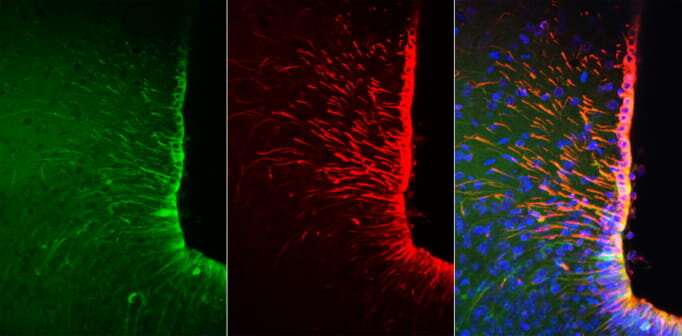

Tanycytes are glial cells, which communicate with neurons in the brain to inform it of what we have eaten. Researchers from the School of Life Sciences at the University of Warwick have found when tanycytes are selectively stimulated appetite was increased.
It has previously been discovered that tanycytes—cells found in part of the brain that controls energy levels—detect nutrients in food and tell the brain directly about the food we have eaten.
Tanycytes do this by responding to amino acids found in foods, via the same receptors that sense the flavor of amino acids (“umami” taste), which are found in the taste buds of the tongue.
In the paper ‘Hypothalamic tanycytes generate acute hyperphagia through activation of the arcuate neuronal network.’ published today, the 8th June, in the journal PNAS, researchers from the School of Life Sciences at the University of Warwick, explain how tanycytes can increase appetite.
Tanycytes are glial cells located in the center of the brain where they line one of the fluid filled spaces known as ventricles. They are able to senses or “taste” the nutrients in the cerebrospinal fluid within the ventricle. The amount of nutrients in this fluid varies depending how much has been eaten. A key question has been whether the tanycytes can relay this information about nutrients to the nearby neurons that regulate appetite and how much energy that is expended via activity or the generation of body heat.
By getting tanycytes to selectively express a light sensitive ion channel, researchers were able to very activate them very specifically and show that this causes nearby neurons to become active. By looking at the identity of the activated neurons the researchers found that the tanycytes could turn on two different pathways involved in the control of feeding.
One pathway is associated with an increased drive to feed, whereas the other pathway is associated a reduced drive to feed and greater energy expenditure. From this it would not be clear which of these two opposed pathways “wins”.
By studying how stimulation of tanycytes changes feeding behavior, the researchers showed that it resulted in a short-term increase in food intake: i.e. the drive to feed more overcame the opposing drive to feed less and expend more energy.
Professor Nicholas Dale, from the School of Life Sciences at the University of Warwick explains:
“Tanycytes respond to nutrients that signal the effect of feeling full, so we’d expect that when tanycytes are stimulated you would eat less, but surprisingly we found that you actually eat more. We have established a link between tanycytes and food intake, but we still don’t completely understand how they will contribute to the control of body weight in the longer term.”
Dr. Matei Bolborea, the first author of the study stated:
Source: Read Full Article